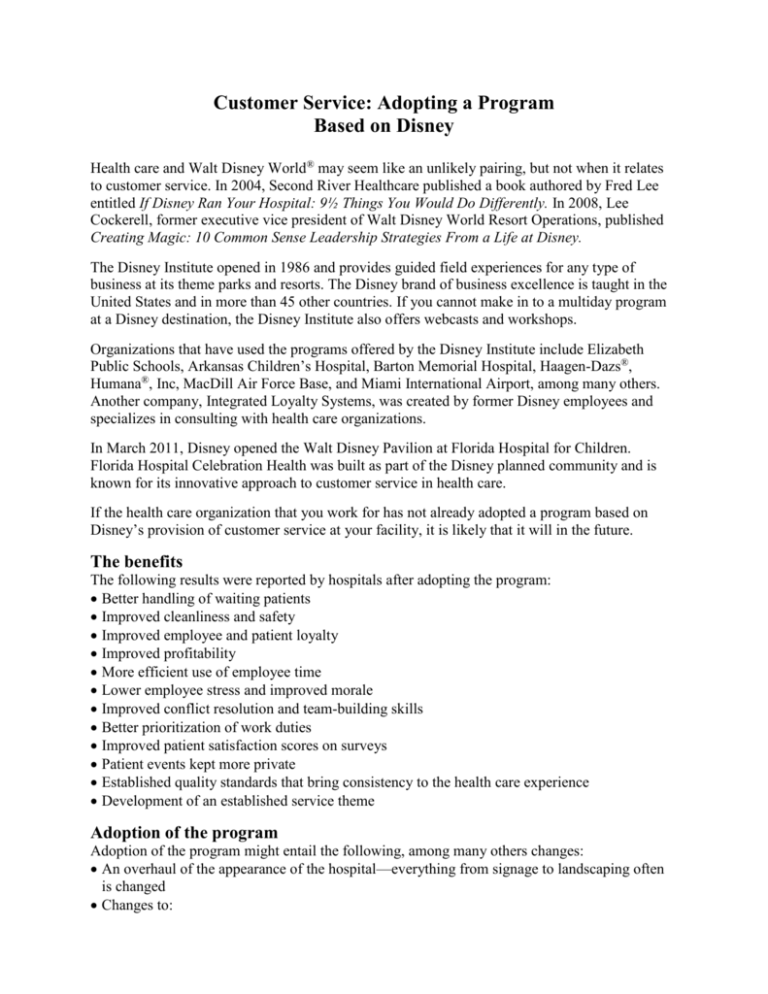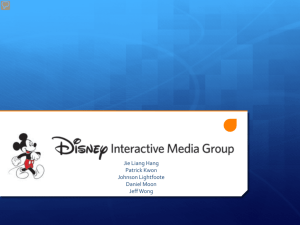Customer Service: Adopting a Program Based on Disney Health
advertisement

Customer Service: Adopting a Program Based on Disney Health care and Walt Disney World® may seem like an unlikely pairing, but not when it relates to customer service. In 2004, Second River Healthcare published a book authored by Fred Lee entitled If Disney Ran Your Hospital: 9½ Things You Would Do Differently. In 2008, Lee Cockerell, former executive vice president of Walt Disney World Resort Operations, published Creating Magic: 10 Common Sense Leadership Strategies From a Life at Disney. The Disney Institute opened in 1986 and provides guided field experiences for any type of business at its theme parks and resorts. The Disney brand of business excellence is taught in the United States and in more than 45 other countries. If you cannot make in to a multiday program at a Disney destination, the Disney Institute also offers webcasts and workshops. Organizations that have used the programs offered by the Disney Institute include Elizabeth Public Schools, Arkansas Children’s Hospital, Barton Memorial Hospital, Haagen-Dazs®, Humana®, Inc, MacDill Air Force Base, and Miami International Airport, among many others. Another company, Integrated Loyalty Systems, was created by former Disney employees and specializes in consulting with health care organizations. In March 2011, Disney opened the Walt Disney Pavilion at Florida Hospital for Children. Florida Hospital Celebration Health was built as part of the Disney planned community and is known for its innovative approach to customer service in health care. If the health care organization that you work for has not already adopted a program based on Disney’s provision of customer service at your facility, it is likely that it will in the future. The benefits The following results were reported by hospitals after adopting the program: Better handling of waiting patients Improved cleanliness and safety Improved employee and patient loyalty Improved profitability More efficient use of employee time Lower employee stress and improved morale Improved conflict resolution and team-building skills Better prioritization of work duties Improved patient satisfaction scores on surveys Patient events kept more private Established quality standards that bring consistency to the health care experience Development of an established service theme Adoption of the program Adoption of the program might entail the following, among many others changes: An overhaul of the appearance of the hospital—everything from signage to landscaping often is changed Changes to: − Hiring criteria − Employee orientation and evaluation processes − Employee work attire − Employee benefit policies − How employee meetings are conducted, with improved efficiency as the goal − Family waiting areas and the addition of more of these areas − Visiting hours Addition of more housekeeping staff and changes to cleaning schedules Better training of employees who answer phones, check in patients, or facilitate transfers within the hospital More recognition for employee achievements Development of a new mission statement Implementation of the “on stage/off stage” system Maintenance of public areas to assure that they are kept clean and free of equipment Extra steps to make each patient’s stay as peaceful as possible—something as simple as providing extra pillows or more entertainment options for waiting rooms Review Date 4/11 G-1584







